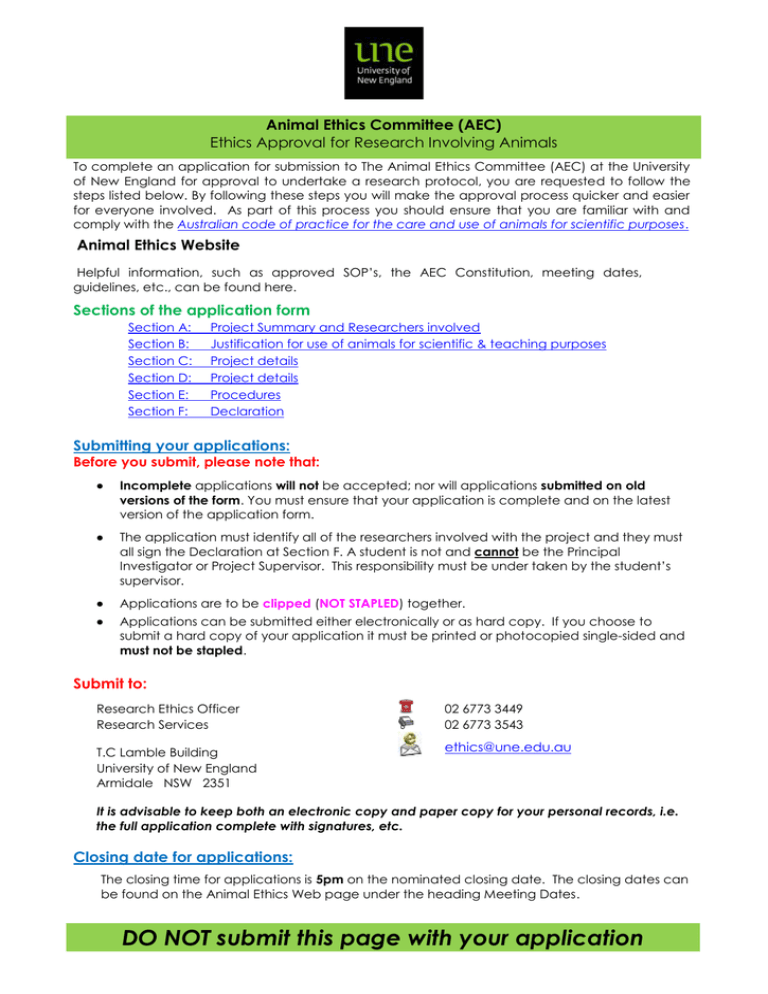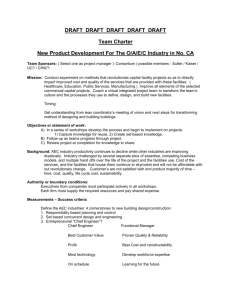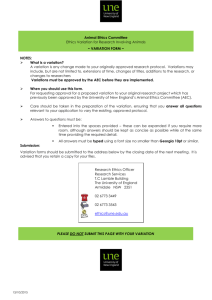Ethics Approval for Research Involving Animals Animal Ethics Committee (AEC)
advertisement

Animal Ethics Committee (AEC) Ethics Approval for Research Involving Animals To complete an application for submission to The Animal Ethics Committee (AEC) at the University of New England for approval to undertake a research protocol, you are requested to follow the steps listed below. By following these steps you will make the approval process quicker and easier for everyone involved. As part of this process you should ensure that you are familiar with and comply with the Australian code of practice for the care and use of animals for scientific purposes. Animal Ethics Website Helpful information, such as approved SOP’s, the AEC Constitution, meeting dates, guidelines, etc., can be found here. Sections of the application form Section A: Section B: Section C: Section D: Section E: Section F: Project Summary and Researchers involved Justification for use of animals for scientific & teaching purposes Project details Project details Procedures Declaration Submitting your applications: Before you submit, please note that: Incomplete applications will not be accepted; nor will applications submitted on old versions of the form. You must ensure that your application is complete and on the latest version of the application form. The application must identify all of the researchers involved with the project and they must all sign the Declaration at Section F. A student is not and cannot be the Principal Investigator or Project Supervisor. This responsibility must be under taken by the student’s supervisor. Applications are to be clipped (NOT STAPLED) together. Applications can be submitted either electronically or as hard copy. If you choose to submit a hard copy of your application it must be printed or photocopied single-sided and must not be stapled. Submit to: Research Ethics Officer Research Services 02 6773 3449 02 6773 3543 T.C Lamble Building University of New England Armidale NSW 2351 ethics@une.edu.au It is advisable to keep both an electronic copy and paper copy for your personal records, i.e. the full application complete with signatures, etc. Closing date for applications: The closing time for applications is 5pm on the nominated closing date. The closing dates can be found on the Animal Ethics Web page under the heading Meeting Dates. DO NOT submit this page with your application Office use: Reference Number Date Received Animal Ethics Committee (AEC) Ethics Approval for Research Involving Animals SECTION A – PROJECT Project Title This title will be recorded on the ethics database and used in all correspondence in relation to this project Project Summary Provide a lay persons snapshot of the project. PART A2 – PRINCIPAL INVESTIGATOR or PROJECT SUPERVISOR (this is not the research student) This is the person whom the research team wishes the AEC to correspond with in relation to this project. Only UNE researchers can be listed as contact person for an ethical clearance application. In the case of student research, a member of the student’s supervisory team must be listed. Name (eg Dr John Smith) (one name only) UNE Staff Number Animal Ethics Course Number Qualifications School/Employer Mailing Address Work Phone No. After Hours Phone No. Email Address AEC Application Form – 13/04/2016 2 of 19 PART A3 – CO-INVESTIGATOR/CO-SUPERVISOR other than student researchers List all co-investigators (associates, technicians etc) on the project who are not students conducting the research as a component of their studies. This includes Co-Supervisors. However, if students of the University are working on the project, e.g. as research assistants, but not using the research for their studies, they should be listed here. Name (eg Dr Logan Croft) UNE Staff/Student Number Animal Ethics Course Number Qualifications Role School/Employer Mailing address Work Phone No. After Hours Phone No. Email Name (eg Mr Bill Dawson) UNE Staff/Student Number Animal Ethics Course Number Qualifications Role School/Employer Mailing address Work Phone No. After Hours Phone No. Email Copy this table and repeat for any additional co-investigators. AEC Application Form – 13/04/2016 3 of 19 PART A4 – STUDENT RESEARCHERS List all students working on the project who are conducting the research as a component of their studies. Name (eg Mr Mohamed Ali) UNE Student Number Animal Ethics Course Number Qualifications School Mailing address Phone No. Fax No. Email (please use UNE email) Name of degree program Undergraduate University of New England? Yes Honours Postgraduate Coursework Postgraduate Research Other (please specify): Principal supervisor Copy this table and repeat for each additional student. AEC Application Form – 13/04/2016 4 of 19 SECTION B – JUSTIFICATION FOR USE OF ANIMALS FOR SCIENTIFIC AND TEACHING PURPOSES No animals may be used without prior approval of an approved Animal Ethics Committee, which includes both scientists and lay representatives of the community. Hence all answers in Section B must be in language a lay person can understand. The Code of Practice states that: “Scientific and teaching activities using animals may be performed only when they are essential: (insert X in box) B1 To obtain and establish significant information relevant to the understanding of humans and or animals; Yes No B2 For the maintenance and improvement of human and or animal health or welfare; Yes No B3 For the improvement of animal management or production; Yes No B4 To obtain and establish significant information relevant to the understanding, maintenance or improvement of the natural environment; or Yes No B5 For the achievement of educational objectives (Point 1.1, p5) Yes No B6. The Code of Practice states that: “Techniques that totally or partially replace the use of animals for scientific purposes must be sought and used wherever possible” (Point 1.8, p 6) B6.1 Are any alternatives other than the use of animals available for this procedure? Yes No If yes please give details (Max 1,000 words) The following World Wide Web sites may help identify possible alternatives to using live animals. http://www.ahc.umn.edu/rar/ethics.html - University of Minnesota – Research Animal Resources – Ethics and Alternatives http://altweb.jhsph.edu – John Hopkins Bloomberg School of Public Health – Search for Alternatives http://www.nal.usda.gov/awic/pubs/antibody/ - Information Resources for Adjuvants and Antibody Production: Comparisons and Alternative Technologies http://oslovet.norecopa.no/dokument.aspx?dokument=80&mnu=about _us– The Norwegian Reference Centre for Laboratory Animal Science & Alternatives AEC Application Form – 13/04/2016 5 of 19 If alternatives are not being used, please explain why? B6.2 Details (Max 1,000 words) Briefly state the aims of the experiment, specifying anticipated outcomes. (Complete the Appendix if this is a teaching application): B7 Details (Max 1,000 words) B8 Answer the following with regard to the wellbeing of the animals used in this protocol. This should include all measurements, dose rates, frequency, volume etc. (Researchers are reminded that their responsibility for animals begins from the time they receive the animals up until the time they are disposed of at the completion of the protocol.) a) Briefly list in point form, what will happen to the animals? b) What will be the effects of this on the animals? c) How will any negative effects of this be minimised? AEC Application Form – 13/04/2016 6 of 19 SECTION C – PROJECT DETAILS – Answer all questions C1 Briefly in ‘plain English’, state the aims of the experiment and justify the benefits to either humans or animals and the level of impact on the wellbeing of the animals used in the protocol. Details (Max 1,000 words) C2 Specify for each person listed in Section A their level of experience with the procedures and animals being used in this protocol if they have no experience, describe how the relevant experience will be obtained. Details (Max 100 words per researcher) C3 C4 Have any of the nominated researchers ever had a research authority cancelled? If yes, please state which researchers Have all the nominated researchers completed an Animal Ethics course or similar training (e.g. ANPR321 or ANSC304)? If No, please state which researchers have not. Yes Yes No No The researchers are reminded that this course must be completed before the research can be approved. C5 Nominate the initial contact person in the case of an emergency. This person is listed on the authority as the emergency C6 If applicable provide the name of farmer/manager and any other relevant personnel involved in the day-to-day management of the study animals. AEC Application Form – 13/04/2016 7 of 19 SECTION D – PROJECT DETAILS – Answer all questions D1. Indicate from the list of purposes provided those that apply to this protocol. Please bold the appropriate number(s) & description(s): 1 Stock breeding 2 3 4 5 Stock maintenance Education Research: Human or animal biology Research: Human or animal health & welfare D2 D3 6 7 8 9 10 Research: Animal management or production Research: Environmental study Production of biological products Diagnostic procedures Regulatory product testing Is this a new or an ongoing protocol? If ONGOING, please indicate the prior AEC number (s) Has the research been approved, or is under consideration, by another Animal Ethics Committee (AEC)? If Yes, and approved, attach a copy of the approval(s). Yes Give details No Go to D4 Duration of data collection for research. (‘Start date’ must be after meeting date) Approval is granted for a 12-month period for a research project. Applications for teaching or maintenance protocols may be granted for a 3 year period. Please indicate below the expected commencement and completion dates. Commencement cannot be before the meeting date Start: D5 Ongoing Reference No. Name of other AEC D4 New End: dd/mm/yyyy dd/mm/yyyy Indicate from the list of procedures provided those that apply to this protocol (more than one may apply). Please bold the appropriate number(s) & description(s) in the list below: 6 Minor physiological challenge 2 Observation involving minor interference Animal unconscious without recovery 7 Major physiological challenge 3 Minor conscious intervention 8 4 Minor surgery with recovery 9 Death as an end point ie LD50 or LC50 Production of genetically modified animals 5 Major surgery with recovery 1 AEC Application Form – 13/04/2016 8 of 19 D6 List all animals to be used in this project (complete the Appendix if this is a teaching application): Species Category No.: Species (Common name): Breed/Strain: Age: Sex: Number required: Source: Conservation status (if applicable): Life span of wild-caught animals (i) in the wild: (ii) in captivity: Copy and paste this section again if more than one species is used D7 Does this project involve the use of any animals that have been the subject of previous research? If animals are to be re-used, individual records must be kept for each animal and this must be indicated in the final report. Yes No If Yes, what has previously been done to the animals? Also please provide the relevant AEC Approval number(s) and Project Name: Justify the re-use of the animals, in relation to the potential welfare implications for their re-use. D8 Provide the location(s) (and full address (es)) of where the animals will be housed from the time of entry into the experiment until the time of its completion. (on UNE property, National Parks or elsewhere): Site(s) e.g. Animal House, Ring Road, UNE NSW 2351 D9 Have you booked facilities for holding the animals Yes Go to D10 D10 Have you completed the Animal Entry form? (This must be completed before animals can be held in the Animal House Complex.) Yes Go to D11 AEC Application Form – 13/04/2016 No Go to D11 N/A Go to D11 No Go to D11 N/A Go to D11 9 of 19 D11 Provide the methods and means by which animals will be monitored during maintenance. Type of housing (building, cage, pen or paddock): Number of animals per building, cage, pen or paddock What arrangements have been made for the monitoring, care, feeding, etc. of the experimental animals during each phase of the project? D12 Are animals likely to be bred from during the period of the protocol? AEC Application Form – 13/04/2016 Yes No Unknown 10 of 19 SECTION E – PROCEDURES E1.1 Describe the experimental design (label or number multiple procedures and complete the Appendix if this is a teaching application). E1.2 Explain how the number of animals used is appropriate for the level of significance required, the minimum difference expected and the variability existing for the trait measured. E1.3 Provide a full sequential description of what happens to the animals from the time you obtain them to the time the experiment is completed. (This must be provided in the table below using the headings in the table.) Study Day Eg: -14 to -1 Activity Sheep acclimatise to paddock. Sheep drenched (with BZ+LV anthelmintic) and vaccinated if required. E2 For the procedures you have listed in answer to Question D5 provide details on how the impact on the animals’ wellbeing will be minimized. If available identify any appropriate SOP(s). E3 What procedures are in place to minimise distress in case of injury or major compromise to animal wellbeing? (If euthanasia, see Question E9) AEC Application Form – 13/04/2016 11 of 19 E4 Will surgery be performed on the animal(s)? Yes No Go to E7 If Yes, describe the procedures. Will it be performed; under general anaesthesia, under local anaesthesia or without anaesthesia (quote standard procedure if possible. E5 Give details of any anaesthesia process E6 What post-operative care, monitoring and analgesia will be used? E7 Describe how animals will be disposed of at the end of the experiment, (e.g. returned to flock, passed on to another researcher, euthanised, released to the wild, re-homed, etc.) E8 If animals are to be released to the wild, outline the methods for ensuring maximum success and indicating how the site of capture/release has been considered. E9.1 If, as the result of serious illness, serious accidental injury or in order to fulfil any other ethical requirement, animals need to be euthanised, please provide details of: the method of euthanasia: the names and qualifications of the persons carrying out the euthanasia: Names: Qualifications: AEC Application Form – 13/04/2016 12 of 19 E9.2 Are animals to be euthanised as part of this protocol? If Yes, please provide details of: Yes No the method of euthanasia: the names and qualifications of the persons carrying out the euthanasia: Names: Qualifications: Are any drugs, chemicals, ionising or non-ionising radiation, or biological agents to be used? Yes, go to Question E11 No, go to Question E18 E11 Are neuromuscular blocking agents to be used? Yes, go to Question E11.1 No, go to Question E12 E11.1 Will an anaesthetic or analgesic agent be administered simultaneously? Yes No E11.2 Will an anaesthetic or analgesic agent be administered for each agent? Yes No E10 E12 List all drugs, chemicals, ionising or non-ionising radiation or biological agents to be used. For each agent indicate: Name of agent: Dose of agent: Route of administration: Likely effects of agent: Duration of effects: Method of determining effectiveness of agent: Method of determining pain responses occurring during neuromuscular blockage: Availability of reversing agent(s): Availability of cardio-respiratory support facilities: Possible side-effects of or toxicity reactions to the agent: Copy and paste this section again if more than one agent is used. AEC Application Form – 13/04/2016 13 of 19 E13 E14 Has the appropriate Safety Officer been notified? Yes Are any imported biological products or their derivatives to be used in any of the animals? If Yes, give the AQIS approval numbers: No N/A Yes No E15 Are there any anticipated health risks to staff: If Yes, describe how these will be minimised. Yes No E16 Are there any anticipated health risks to other animals? If Yes, describe how these will be minimised. Yes No Yes No E17 Do the proposed waste disposal procedures comply with the Protection of the Environment Administration Act (1991) the Occupational Health and Safety Act (2000) and Regulations and the Radiation Control Act (2003)? E18 For experiments involving Native wildlife, is a licence or permit from the relevant State wildlife authority (e.g. NPWS, NSW Agriculture) required? Yes No N/A If Yes, Is one held by the Principal Investigators? Name of Licensing Body/Organisation: Licence Class/Descriptions(s) and Number(s): Expiry Date of Licence(s)? A copy of this permit is required to be provided with this application. If No, explain why a licence or permit is not required. AEC Application Form – 13/04/2016 14 of 19 E19 Is the research funded by an internal or external grants body or sponsor? Yes No Go to Section F Yes No Go to Section F Give details Organisation or Funding Body Project title on contract or funding application First named investigator Administering institution Does the funding body have ownership of or control over the dissemination of results? If yes give details. Copy this table and repeat for each contract or grant. E19.2 Does the funding constitute a conflict of interest for either the researcher(s) or provider(s) of the funding? Give details Details (Max 300 words) AEC Application Form – 13/04/2016 15 of 19 SECTION F – DECLARATION MADE BY THE PERSON(s) RESPONSIBLE: IT IS EXPECTED THAT YOU WILL COMPLY WITH THE CONDITIONS OF THIS DECLARATION, SO PLEASE READ CAREFULLY BEFORE SIGNING. (a) I acknowledge that: 1. The care and maintenance of all animals is my responsibility though the work may be delegated to suitably trained or experienced staff or students; 2. The Australian Code of Practice for the Care and Use of Animals for Scientific Purposes (1997) requires an autopsy to be performed when animals die unexpectedly; and 3. I may proceed with the experiment only when UNE has issued an Animal Research Authority, which names all suitably qualified and/or experienced persons who are to be involved in the described project. (b) I certify that: 1. My Animal Research Authority will be displayed where the animals are housed and where animal experimentation is to occur, and the AEC will be notified immediately should any changes in participating personnel occur; 2. Where appropriate I am the holder of a current permit from the relevant state wildlife authority to capture and hold Australian native fauna; 3. All personnel involved in the described animal experiment have appropriate and adequate qualifications and skills and/or they will be under suitably close supervision to enable them to competently carry out the necessary tasks; 4. All unplanned deaths will be reported to the UNE Animal House Manager and the AEC Secretary and I will comply with his/her instructions concerning an autopsy; 5. Any information required to facilitate the maintenance of animals will be sought from suitably informed personnel; and 6. The care of animals during the proposed experiment will conform with the principles and regulations of: the Animal Research Act 1985, the Australian Code of Practice For the Care and Use of Animals For Scientific Purposes 1997, the Animal Research Regulation 1995, the Amendments to the Animal Research Regulation 1997, and the UNE Code of Practice for the Care and Welfare of Nonhuman Vertebrate Animals Used for Scientific Purposes. 7. That all personnel listed have read this application and have agreed to comply with procedures described and any conditions imposed by the AEC. All investigators named at A2 , A3 and A4 are to sign this declaration. Print Name Signature Date Principal investigator or project supervisor Co-Investigator , Associate or Student Researcher Co-Investigator , Associate or Student Researcher Co-Investigator , Associate or Student Researcher AEC Application Form – 13/04/2016 16 of 19 Comments You are invited to add comments to supplement your application if you think something has not been covered, or to provide feedback on this form. AEC Application Form – 13/04/2016 17 of 19 APPENDIX: SCHEDULE OF PRACTICAL CLASSES Course Code: Date Lecturer AEC Application Form – 13/04/2016 Title/Description of Unit/Course Species 18 of 19 No. of Purpose Animals No. Procedure No. APPENDIX – How to submit your application DO NOT submit these instructions with your application Before you submit: Incomplete applications will not be accepted so ensure that your application is complete and collated in the format listed below. The application must identify all of the researchers involved with the project and they must all sign the Declaration at Part F1. The Student is not and cannot be the Principal Investigator or Project Supervisor this must be the Supervisor Note: It is the applicant’s responsibility to ensure the completed declaration is submitted with their application. Applications are to be clipped (NOT STAPLED) Applications can be submitted either electronically or hard copy. If you choose to submit a hard copy of your application it must be printed and photocopied single-sided and must not be stapled. Submit to: Research Ethics Officer Research Services T.C Lamble Building University of New England Armidale NSW 2351 02 6773 3449 02 6773 3543 (International prefix +61 2) ethics@une.edu.au It is advisable to keep both an electronic copy and paper copy for your personal records, i.e. the full application complete with signatures etc. Closing date for applications: The closing time for applications is 5pm on the nominated closing date. The closing dates can be found on the Animal Ethics Web page under the heading Meeting Dates, or can be obtained by clicking on the heading above. DO NOT submit these instructions with your application


